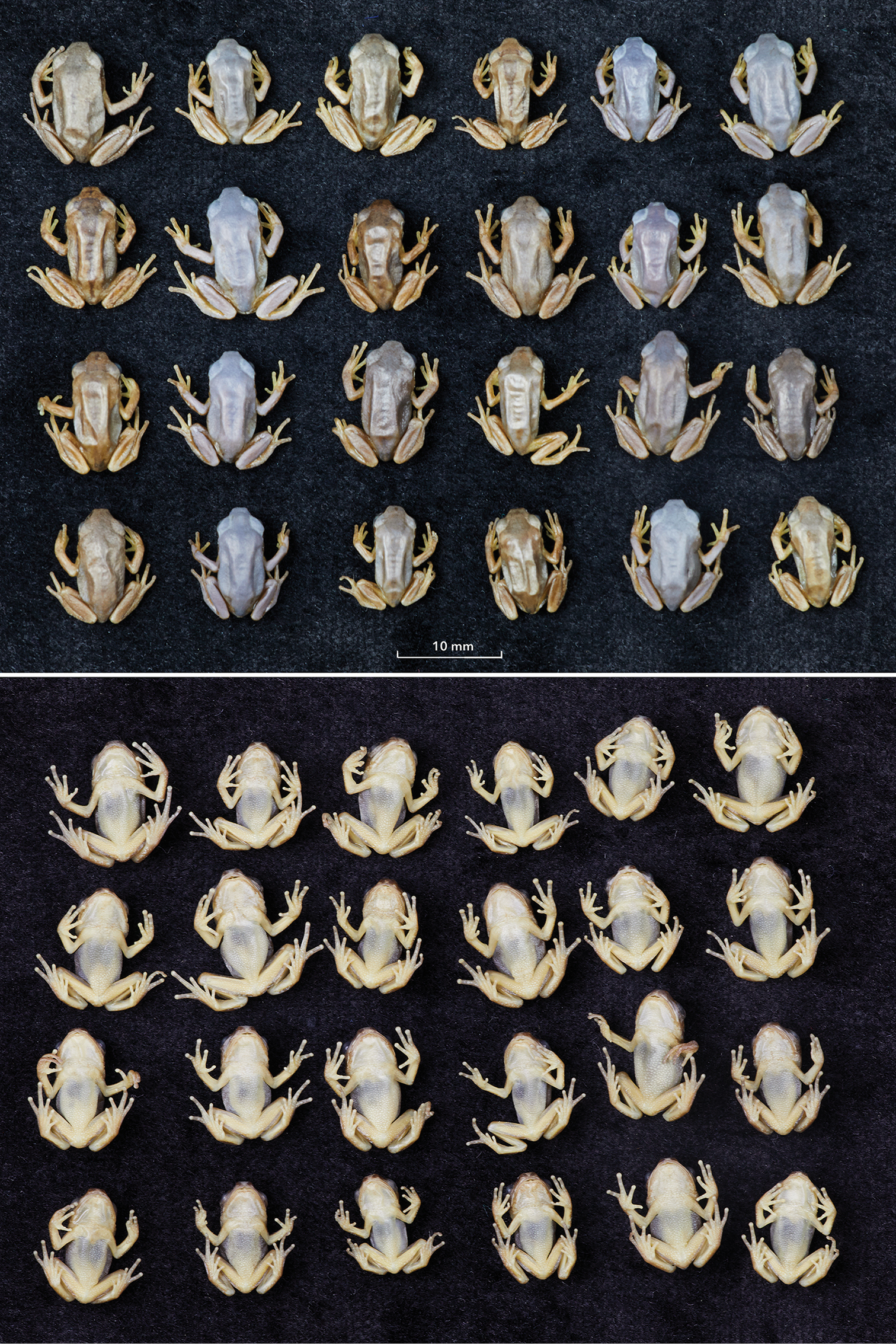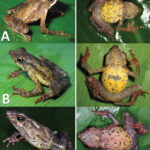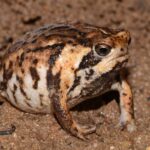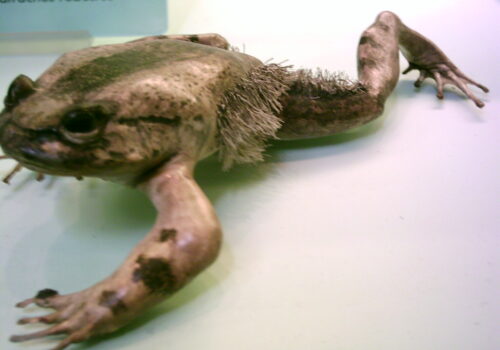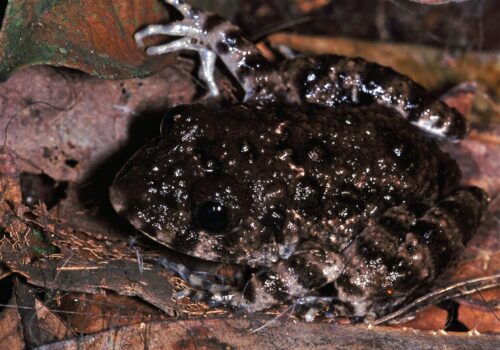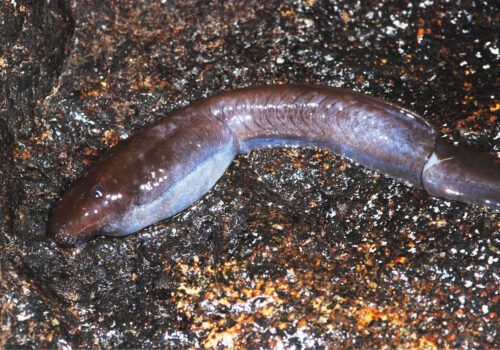Leptopelis diffidens: The Enigmatic Chorus of Africa’s Hidden Forests#
Deep within the lush, mist-shrouded forests of the Ethiopian Highlands, a gentle nocturnal symphony emerges at twilight. A chorus of soft chirps and sweet whistles settles through moss-covered branches and dew-kissed leaves, a harmonious soundtrack performed by a creature few have had the privilege to encounter—the elusive Leptopelis diffidens. Also commonly known as the Bale Forest Treefrog, Leptopelis diffidens skitters quietly among tree ferns and forest streams, contributing to the intricate tapestry of life within these emerald havens.
With a Latin name translating roughly to “diffident” or “shy,” this charming amphibian embodies quiet grace, retreating discreetly from the slightest disturbance. Despite its modest demeanor, Leptopelis diffidens plays an essential ecological role within its delicate habitats and has fascinated researchers and naturalists alike for decades.
Taxonomy and Classification#
Leptopelis diffidens belongs to the family Arthroleptidae—a diverse family of treefrogs known for their distinctive calling behaviors and arboreal lifestyle. Within this family, the genus Leptopelis is widespread across sub-Saharan Africa, comprising numerous species that inhabit varied ecosystems, from lush lowland rainforests to elevated montane woodlands.
The species was scientifically described by Largen in 1975, recognizing its distinct vocalizations, careful habits, and unique physical traits. Closely related to several other Ethiopian treefrog species, Leptopelis diffidens can be difficult to distinguish at first glance; detailed morphological observation and behavioral analysis are typically necessary to confirm accurate identification.
Natural Habitat#
Endemic to Ethiopia, Leptopelis diffidens thrives within a restricted geographic range, occupying dense montane forest habitats predominantly within the Bale Mountains National Park. Here, the delicate ecosystems weave through towering juniper trees, sprawling bamboo forests, and cool alpine meadows. Streams and small watercourses crisscross the terrain, providing essential breeding sites and refuge against the backdrop of moist, moss-lined understories.
This shy treefrog has adapted meticulously to life in these high-elevation habitats—typically found between altitudes of 1900 to 3000 meters above sea level. Highly sensitive to microclimatic variables, Leptopelis diffidens prefers damp, shaded environments where humidity remains constant, and temperatures fluctuate minimally. Within this tranquil sanctuary, it spends daylight hours hidden among leafy vegetation, emerging only as dusk descends and cooler temperatures beckon its nocturnal activities.
Given its affinity for pristine natural habitats, the presence and abundance of Leptopelis diffidens indicate the overall ecological integrity, making it a vital indicator of forest health in these mountainous landscapes.
Physical Characteristics#
Leptopelis diffidens is a diminutive and delicately crafted amphibian, measuring approximately 28 to 35 millimeters from snout to vent, with males notably smaller than females. Like many arboreal frogs, it features an elegant build with smooth, slightly granular skin that assists in retaining moisture while camouflaging effectively among moss and lichen-covered branches.
The frog’s coloration is a fascinating testament to nature’s artistry; individuals exhibit patterns of subtle greens, browns, and sometimes greyish shades that blend impeccably within their surroundings. Darker blotches, irregularly dispersed across the frog’s dorsal surface, further enhance cryptic camouflage, making the frog nearly indistinguishable against the backdrop of the dense, verdant foliage.
Sticky, broad pads at the tips of its toes are an essential adaptation, granting Leptopelis diffidens expert climbing capability. These specialized pads secure the frog effortlessly upon moist, slippery vegetation, allowing it to maneuver swiftly through the labyrinthine forest canopy or deftly leap from one plant to another in the shadowy understory.
Behavior and Life Cycle#
A Quiet Life Amongst Leaves#
True to its scientific moniker, Leptopelis diffidens is exceptionally secretive and shy, often going unnoticed even by seasoned herpetologists. As night falls, activity increases subtly; males perch prominently on low-hanging plants or tree branches near water sources. From these vantage points, they unleash soft, melodic calls—distinct short whistles and chirps—to attract potential mates. These vocalizations echo gently through the forest, blending indistinguishably with the subtle nocturnal sounds of crickets, insects, and distant bird calls, lending an ethereal quality to the nighttime forest acoustics.
Feeding Habits#
Employing specialized adaptations, Leptopelis diffidens feeds opportunistically upon an array of nocturnally active invertebrates. Using its keen eyesight, rapid tongue projection, and agile movements, it preys upon insects such as beetles, flies, moths, and ants. Its quiet hunting strategy revolves around patiently lingering undetected on vegetation, striking precisely and swiftly—a perfect epitome of stealth and decisive action.
Reproduction and Development#
The lifecycle of Leptopelis diffidens starts with the wet season rains that awaken their reproductive instincts. Male frogs gather around still pools, marshes, or slow-flowing streams and start their chorus to attract females. Once a female selects a mate, egg-laying occurs discreetly on vegetation above shallow water bodies. Egg masses typically contain few dozen eggs, gelatinous capsules protecting developing embryos from dehydration and predators.
Upon hatching, the tadpoles drop gently from their leafy nurseries into pools below, commencing a wholly aquatic larval stage. Their lifestyle shifts dramatically as they metamorphose, developing limbs, lungs, and eventually losing their tails. The emerging froglets find themselves adapting quickly to arboreal life, where they will spend adulthood concealed above the forest floor.
Ecological Role#
Leptopelis diffidens fulfills a crucial ecological niche as both predator and prey, actively contributing to the delicate balance within its montane ecosystem. As insectivorous predators, they limit insect populations, some of which could become harmful to plant communities if unchecked. Simultaneously, by offering sustenance for larger predators, these amphibians connect critical components within the food web, sustaining the balance and harmony of biodiversity.
Additionally, their sensitivity to environmental changes positions them as vital indicator species. Monitoring populations of Leptopelis diffidens offers valuable insight into ecosystem health and has significant implications for broader conservation efforts.
Threats and Conservation Status#
While not extensively studied, Leptopelis diffidens currently holds the status “Vulnerable” according to the International Union for Conservation of Nature (IUCN). Restricted distribution combined with ongoing challenges places this delicate species at heightened risk of decline without conservation intervention.
The foremost threat remains habitat degradation driven primarily by deforestation, agriculture expansion, livestock grazing, and human settlement encroachment within its mountainous habitats. Climate change also amplifies these threats, altering local rainfall patterns, temperatures, and fragile microhabitats that define their survival.
Dedicated conservationists and researchers are currently highlighting the need for more extensive studies to accurately assess populations and trends. Protected areas in the Bale Mountains provide vital sanctuaries, though expanding conservation zones and establishing habitat corridors may significantly enhance long-term prospects for Leptopelis diffidens.
Cultural and Scientific Significance#
Although relatively obscure among local cultures, amphibians like Leptopelis diffidens have recently become symbolic of conservation campaigns within the region, representing ecological balance and stewardship. Several cultural initiatives in Ethiopia now feature amphibians prominently, as awareness increases about their critical role in ecosystems’ health and stability.
Moreover, scientists have recognized these high-altitude treefrogs as valuable biological indicators, capable of reflecting environmental and climatic shifts over time. By studying their distribution, behavior, and reproductive patterns, researchers gather critical data that helps confront broader conservation challenges.
Conclusion#
Hidden quietly amongst the high-altitude forests of Ethiopia, Leptopelis diffidens symbolizes both the fragility and resilience of nature’s exquisite creations. Understanding and safeguarding this remarkable species require patience, commitment, and comprehensive actions aimed at protecting its vital habitats and ecosystems.
For those seeking to participate in conservation initiatives, support biodiversity research, or simply enhance appreciation for this intricate jewel of nature, recognizing this small frog’s plight is essential. Let the soft calls of Leptopelis diffidens remind us of nature’s urgency, inviting us to advocate, educate, and inspire action to preserve Ethiopia’s rich and wondrous biodiversity for generations to come.

